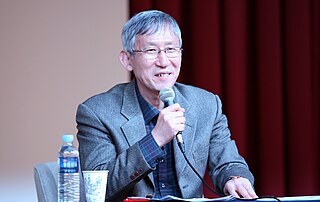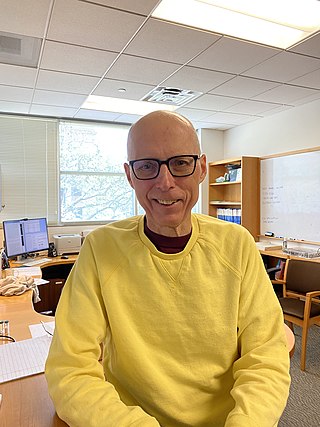Related Research Articles

The Biginelli reaction is a multiple-component chemical reaction that creates 3,4-dihydropyrimidin-2(1H)-ones 4 from ethyl acetoacetate 1, an aryl aldehyde, and urea 3. It is named for the Italian chemist Pietro Biginelli.

Benzothiophene is an aromatic organic compound with a molecular formula C8H6S and an odor similar to naphthalene (mothballs). It occurs naturally as a constituent of petroleum-related deposits such as lignite tar. Benzothiophene has no household use. In addition to benzo[b]thiophene, a second isomer is known: benzo[c]thiophene.

Sir David William Cross MacMillan is a Scottish chemist and the James S. McDonnell Distinguished University Professor of Chemistry at Princeton University, where he was also the chair of the Department of Chemistry from 2010 to 2015. He shared the 2021 Nobel Prize in Chemistry with Benjamin List "for the development of asymmetric organocatalysis".

Peter John Stang is a German American chemist and Distinguished Professor of chemistry at the University of Utah. He was the editor-in-chief of the Journal of the American Chemical Society from 2002 to 2020.

Zoltan George Hajos was a Hungarian-American organic chemist. Originally an academic in his native Budapest, then an industrial chemist in the pharmaceutical industry, he is known for the Hajos–Parrish–Eder–Sauer–Wiechert reaction.

Anthony Gerard Martin Barrett FRS, FMedSci is a British chemist, and Sir Derek Barton Professor of Synthesis, Glaxo Professor of Organic Chemistry at Imperial College London. He is Director of the Wolfson Centre for Organic Chemistry in Medical Science. He was elected a fellow of the Royal Society in 1999 and Academy of Medical Sciences in 2003. He obtained a BSc as well as PhD from Imperial College London in 1973 and 1975 respectively.

Dennis P. Curran is an American organic chemist and a professor of chemistry at University of Pittsburgh known for his research in the fields of organic chemistry, radical chemistry, and fluorous chemistry.
Clark Landis is an American chemist, whose research focuses on organic and inorganic chemistry. He is currently a Professor of Chemistry at the University of Wisconsin–Madison. He was awarded the ACS Award in Organometallic Chemistry in 2010, and is a fellow of the American Chemical Society and the American Association for the Advancement of Science.
Mark S. Cushman is an American chemist, whose primary research is in the area of medicinal chemistry. He completed his pre-pharmacy studies at Fresno State College (now California State University, Fresno) in 1965. He then attended the University of California San Francisco (as a University of California Regents Scholar), earning a Pharm.D. in 1969 and a Ph.D. in Medicinal Chemistry in 1973. Thereafter, he performed postdoctoral training in the laboratory of George Büchi, Ph.D., at the Massachusetts Institute of Technology (MIT). There, his research focused on the discovery and development of new synthetic methodologies, and the isolation and structural characterization of mycotoxins from Aspergillus niger. In 1975, he joined the Department of Medicinal Chemistry and Molecular Pharmacology (at the time, Department of Medicinal Chemistry and Pharmacognosy) at Purdue University. From 1983 to 1984, Prof. Cushman was a Senior Fulbright Scholar at Munich Technical University working in the laboratory of Professor Adelbert Bacher. His sabbatical work dealt with the design and synthesis of probes to elucidate key aspects of the biosynthesis of riboflavin (vitamin B2). Currently he holds the rank of Distinguished Professor Emeritus of Medicinal Chemistry at Purdue University. He has mentored 40 graduate students, 59 postdoctoral researchers, and 5 visiting scholars. He has published 348 papers and holds 41 patents. His work has ~17,000 citations with an h-index of 69. His most cited papers had 471, 403, and 299 citations as of August 2021. He has made seminal contributions to the fields of synthetic and medicinal chemistry including the development of new synthetic methodologies, the synthesis of natural products, and the preparation of antivirals, antibacterials, and anticancer agents, and mechanism probes to understand the function of over thirty macromolecular targets. One of his main scientific contributions is the development of the indenoisoquinolines, molecules that inhibit the action of toposiomerase I (Top1) and stabilize the G-quadruplex in the Myc promoter. Three indenoisoquinolines designed and synthesized by his research group at Purdue University [indotecan (LMP 400), indimitecan (LMP 776), and LMP 744] demonstrated potent anticancer activity in vivo and have completed phase I clinical trials at the National Institutes of Health.

Iwao Ojima is a Japanese-American chemist and university distinguished professor at the State University of New York at Stony Brook. He has been widely recognized for his seminal contributions to a range of chemical research at the multifaceted interfaces of chemical synthesis and life sciences. As rare accomplishments, he has received four National Awards from the American Chemical Society in four different fields of research. He is also serving as the director of the Institute of Chemical Biology and Drug Discovery (ICB&DD), as well as the president of the Stony Brook Chapter of the National Academy of Inventors.

Sukbok Chang is a South Korean organic chemist. He is a distinguished professor in the Department of Chemistry at Korea Advanced Institute of Science and Technology (KAIST). He is also the director of the Institute for Basic Science (IBS) Center for Catalytic Hydrocarbon Functionalizations (CCHF). He was an associate editor on ACS Catalysis and has served on the editorial advisory boards of The Journal of Organic Chemistry, Journal of the American Chemical Society, and Accounts of Chemical Research. His major research interest is transition metal catalyzed C-H bond functionalization for the carbon-carbon bond and carbon-heteroatom bond formation.
Cross dehydrogenative coupling (also known as CDC reaction), coined by prof. Chao-Jun Li of McGill University, is a type of coupling reaction allowing the construction of a carbon–carbon bond or C-Heteroatom bond directly from C-H bonds in the presence of an oxidant, leading to the thermodynamically unfavorable formal removal of a H2 molecule. As such, CDC are couplings belonging to the C-H activation strategy.
The Stahl oxidation is a copper-catalyzed aerobic oxidation of primary and secondary alcohols to aldehydes and ketones. Known for its high selectivity and mild reaction conditions, the Stahl oxidation offers several advantages over classical alcohol oxidations.

John A. Gladysz, an organometallic chemist, is a Distinguished Professor and holds the Dow Chair in Chemical Invention at Texas A&M University. Professor Gladysz is a native of the Kalamazoo, Michigan area. He obtained his B.S. degree from the University of Michigan (1971) and his Ph.D. degree from Stanford University (1974). He subsequently held faculty positions at UCLA (1974-1982) and the University of Utah (1982-1998). He then accepted the Chair of Organic Chemistry at the University of Erlangen-Nuremberg in Germany. In 2008, he returned to North America as a distinguished professor and holder of the Dow Chair in Chemical Invention at Texas A&M University.
Marisa C. Kozlowski is an American chemist who is Professor of Organic and Catalysis Chemistry at the University of Pennsylvania. Her research considers asymmetric synthesis and the development of cost effective catalysts. She was elected Fellow of the American Association for the Advancement of Science in 2012 and American Chemical Society in 2013.
T.V. (Babu) RajanBabu is an organic chemist who holds the position of Distinguished Professor of Chemistry in the College of Arts and Sciences at the Ohio State University. His laboratory traditionally focuses on developing transition metal-catalyzed reactions. RajanBabu is known for helping develop the Nugent-RajanBabu reagent, a chemical reagent used in synthetic organic chemistry as a single electron reductant.
Jin-Quan Yu is a Chinese-born American chemist. He is the Frank and Bertha Hupp Professor of Chemistry at Scripps Research, where he also holds the Bristol Myers Squibb Endowed Chair in Chemistry. He is a 2016 recipient of the MacArthur Fellowship, and is a member of the American Academy of Arts and Sciences, American Association for the Advancement of Science, and the Royal Society of Chemistry. Yu is a leader in the development of C–H bond activation reactions in organic chemistry, and has reported many C–H activation reactions that could be applicable towards the synthesis of drug molecules and other biologically active compounds. He also co-founded Vividion Therapeutics in 2016 with fellow Scripps chemists Benjamin Cravatt and Phil Baran, and is a member of the scientific advisory board of Chemveda Life Sciences.

Kay Michille Brummond is an American synthetic chemist who is Professor of Chemistry and Associate Dean of Faculty at the University of Pittsburgh. Her interests consider cycloaddition reactions that can realise molecules and natural products for organic photovoltaics and targeted covalent inhibitors. She was elected a Fellow of the American Chemical Society (ACS) in 2010, a Fellow of the AAAS in 2021, and awarded the ACS National Award for Encouraging Women into Careers in the Chemical Sciences in 2021.
Jennifer Schomaker is an American chemist who is a professor at the University of Wisconsin–Madison. Her research considers the total synthesis of natural and unnatural products. She was selected as an American Chemical Society Arthur C. Cope Scholar Awardee in 2021.
Kathlyn Ann Parker is a chemist known for her work on synthesis of compounds, especially organic compounds with biological roles. She is an elected fellow of the American Chemical Society and a recipient of the Garvan–Olin Medal in chemistry.
References
- 1 2 "Peter Wipf, PhD". University of Pittsburgh Department of Pharmacology and Chemical Biology website. University of Pittsburgh. Archived from the original on 2019-02-02. Retrieved 2017-03-10.
- 1 2 "Peter Wipf / Department of Chemistry". University of Pittsburgh Department of Chemistry website. University of Pittsburgh. Archived from the original on 2017-03-12. Retrieved 2017-03-10.
- 1 2 3 4 5 "Peter Wipf, PhD Biographical Sketch" (PDF). University of Pittsburgh Department of Chemistry website. University of Pittsburgh . Retrieved 2017-03-10.
- ↑ "Policy and Procedure Governing Appointments to Distinguished Professorships". University of Pittsburgh Faculty Handbook. University of Pittsburgh. 2013-02-05. Archived from the original on 2007-09-05. Retrieved 2017-03-16.
- ↑ "Peter Wipf Wins Morley Medal". Chemical & Engineering News. American Chemical Society. 2013-07-22. Archived from the original on 2017-03-12. Retrieved 2017-03-10.
- ↑ ""Wipf P"[au]". PubMed.gov. US National Library of Medicine, National Institutes of Health. Archived from the original on 2017-03-14. Retrieved 2017-03-10.